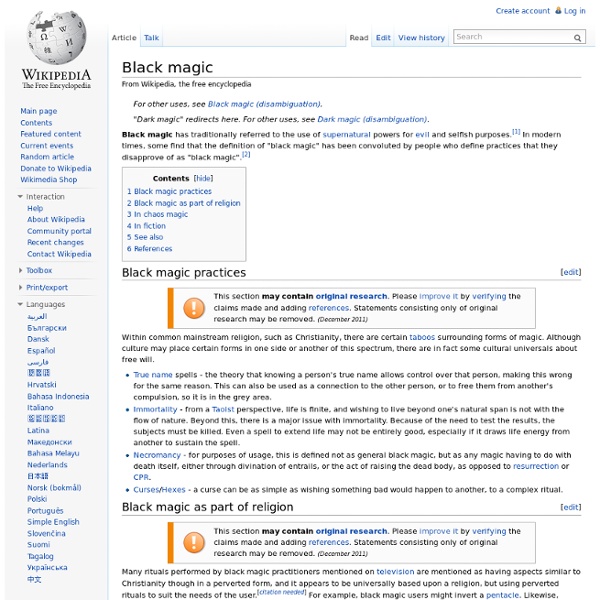Helm of Awe
Welcome | A Sense of Serenity
Kalku
Description[edit] The kalku is a semi-mythical character that has the power of working with wekufe "spirits or wicked creatures". An example of a wekufe is the Nguruvilu. The kalku also have as servants other beings such as the Anchimayen, or the Chonchon (which is the magical manifestation of the more powerful kalku). A mapuche kalku is usually an inherited role, although it could be a machi that is interested in lucrative ends, or a "less powerful", frustrated machi who ignores the laws of the admapu (the rules of the Mapuches). See also[edit] References[edit] Ana Mariella Bacigalupo.Shamans of the foye tree: gender, power, and healing among Chilean Mapuche. External links[edit]
Witchcraft
The belief in and the practice of magic has been present since the earliest human cultures and continues to have an important religious and medicinal role in many cultures today.[1] "Magic is central not only in 'primitive' societies but in 'high cultural' societies as well.. The concept of witchcraft as harmful is often treated as a cultural ideology providing a scapegoat for human misfortune.[3][4] This was particularly the case in the early modern period of Europe where witchcraft came to be seen as part of a vast diabolical conspiracy of individuals in league with the Devil undermining Christianity, eventually leading to large-scale witch-hunts, especially in Protestant Europe. Etymology[edit] From the Old English wiccecræft, compound of "wicce" ("witch") and "cræft" ("craft").[7] Definitions[edit] As in anthropology, European witchcraft is seen by historians as an ideology for explaining misfortune; however, this ideology manifested in diverse ways. Demonology[edit] White witches[edit]
9f6875293c9c589abd893aa848fecefa
Shapeshifting
The concept is present in antiquity, and may indeed be a human cultural universal. It is present in the oldest forms of totemism or shamanism, as well as the oldest extant literature and epic poems (such as the Gilgamesh Epic or the Iliad). The shape-shifting is usually induced by the act of a deity; it persisted into the literature of the Middle Ages and the modern period (where the agency causing shape-shifting is mostly a sorcerer or witch). It remains a common trope in modern fantasy, children's literature, and works of pop culture. By far the most common form of shape-shifting is therianthropy which is the transformation of a human being into an animal (or conversely of an animal into human form). Themes in shapeshifting[edit] Shapeshifting may be used as a plot device, such as when Puss in Boots in the movie Shrek 2 tricks the ogre, Shrek, into becoming a mouse to be eaten. Examples of this are in fairy tales. Between the sexes[edit] Mythology[edit] Modern fiction[edit] L.
keep-calm-and-practice-wicca-1
Witchcraft, Wiccan and Pagan Index | Celtic Connection
Mare (folklore)
A mare or nightmare (Proto-Germanic: *marōn; Old English: mære; Old Norse: mara; German: Nachtmahr) is an evil spirit or goblin in Germanic folklore which rides on people's chests while they sleep, bringing on bad dreams (or "nightmares").[1] The word "mare" comes (through Middle English mare) from Old English mære, mare, or mere, all feminine nouns. These in turn come from Common Germanic *marōn. *Marōn is the source of Old Norse: mara (from which come Swedish: mara; Icelandic: mara; Faroese: mara; Danish: mare; Norwegian: mare/mara), Dutch: (nacht)merrie, and German German: (Nacht)mahr. The -mar in French cauchemar ("nightmare") is borrowed from the Germanic through Old French mare.[1] The word can ultimately be traced back to the reconstructed Proto-Indo-European root *mer-, "to rub away" or "to harm".[2] In Norwegian and Danish, the words for "nightmare" are mareritt and mareridt respectively, which can be directly translated as "mare-ride". In Romania they were known as Moroi.
Online Wicca College & Wiccan Degree Programs | Sacred Mists
Wicca
Un article de Wikipédia, l'encyclopédie libre. Le pentacle, un des principaux symboles des wiccans. La Wicca est un mouvement religieux basé sur l'« Ancienne Religion » définie par Gerald Gardner et incluant des éléments de croyances telles que le chamanisme, le druidisme, et les mythologies gréco-romaine, slave, celtique et nordique. Ses adeptes, les wiccans, prônent un culte envers la nature, et s'adonnent à la magie. La Wicca est un culte à mystères. Sens du terme[modifier | modifier le code] Pour Gardner, wicca avait à l’origine le sens d’« art des sages ». Histoire[modifier | modifier le code] Origines[modifier | modifier le code] La Wicca s'inscrit dans la mouvance européenne du néopaganisme de la première moitié du XXe siècle. Évolution du mouvement[modifier | modifier le code] D'abord confinée à un cercle restreint, la Wicca s'est progressivement développée dans les pays anglo-saxons où elle constitue la principale forme de néopaganisme. Le divin[modifier | modifier le code] En anglais
Crone
The crone is a stock character in folklore and fairy tale, an old woman. In some stories, she is disagreeable, malicious, or sinister in manner, often with magical or supernatural associations that can make her either helpful or obstructing. The Crone is also an archetypal figure, a Wise Woman. She is marginalized by her exclusion from the reproductive cycle,[1] and her proximity to death places her in contact with occult wisdom. As a character type, the crone shares characteristics with the hag. Etymology[edit] As a noun, crone entered the English language around the year 1390, deriving from the Anglo-French word carogne (an insult), itself deriving from the Old North French carogne, caroigne, meaning a disagreeable woman (literally meaning "carrion"). In hero-journey[edit] Campbell links the "helpful crone" to the fairy godmother.[6] The wicked fairy godmother sometimes appears in the guise of a crone. Examples[edit] Baba Yaga rides a pig and fights the infernal crocodile See also[edit]
Alchemy Works Oils, Incense, Herbs and Seeds for Magic



